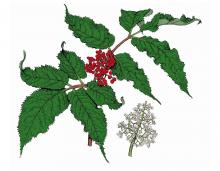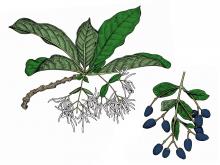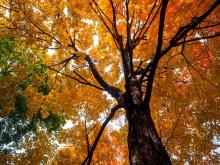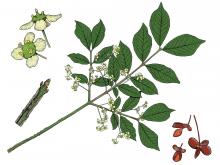Trees, Shrubs and Woody Vines
Media

Species Types
Scientific Name
Sambucus canadensis
Description
Common elderberry is a colony-forming shrub with opposite compound leaves. Its large, flattened clusters of small white flowers produce purple or black berrylike fruits.
Media

Species Types
Scientific Name
Sambucus pubens
Description
Red-berried elderberry reaches 24 feet in height and does not form colonies. Its white flowers, and later, red berries, are in pyramidal clusters. In Missouri, it’s known only from Marion County.
Media

Species Types
Scientific Name
Hypericum prolificum (formerly H. spathulatum)
Description
Shrubby St. John’s-wort has shiny, somewhat leathery, opposite leaves, 2-edged twigs, and flowers with 5 bright yellow petals and many stamens. A shrub growing to 6 feet tall, it is scattered nearly statewide.
Media

Species Types
Scientific Name
Hypericum hypericoides (formerly Ascyrum hypericoides)
Description
St. Andrew’s cross is a small, sprawling shrub up to 3 feet tall, with smooth, opposite leaves, reddish flaky bark, and distinctive yellow flowers with 4 petals. It grows in the southern half of Missouri.
Media

Species Types
Scientific Name
Symphoricarpos orbiculatus
Description
Buckbrush, or coralberry, grows throughout Missouri. This familiar thicket-forming shrub bears dense clusters of pinkish-red berries that persist through most of the winter.
Media

Species Types
Scientific Name
Chionanthus virginicus
Description
White fringe tree is a shrub or small tree that is native to southwest and southeast Missouri. Its fragrant, showy clusters of white, drooping, fringe-like flowers make it a popular for landscaping.
Media

Species Types
Scientific Name
Juniperus ashei
Description
In Missouri, Ashe’s juniper is uncommon and only found in a few southwestern counties; our populations represent the northeastern tip of its range. Here, it is much less widespread than its close relative eastern red cedar.
Media

Species Types
Scientific Name
Acer spp.
Description
Missouri has five species of maples that are either native or naturalized, plus several that are known only in cultivation. Maples are important members of native ecosystems. They also provide stunning fall color, welcome shade in summer, commercially important lumber, and sap for syrup.
Media

Species Types
Scientific Name
Callicarpa americana
Description
American beautyberry is a many-branched shrub that bears attractive rounded clusters of purple berrylike fruits in the axils of the leaves in late summer and fall. A critically imperiled species in Missouri, it is also a popular native shrub for landscaping.
Media

Species Types
Scientific Name
Euonymus alatus
Description
Burning bush, or winged euonymus, is a nonnative shrub that has been very popular in landscaping for its bright red fall foliage. But it is invasive and spreads aggressively into natural habitats, displacing native species.
See Also
About Trees, Shrubs and Woody Vines in Missouri
There are no sharp dividing lines between trees, shrubs, and woody vines, or even between woody and nonwoody plants. “Wood” is a type of tissue made of cellulose and lignin that many plants develop as they mature — whether they are “woody” or not. Trees are woody plants over 13 feet tall with a single trunk. Shrubs are less than 13 feet tall, with multiple stems. Vines require support or else sprawl over the ground.





















